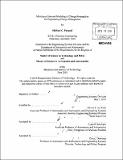Multilayer network modeling of change propagation for engineering change management
Author(s)
Pasqual, Michael C
DownloadFull printable version (12.01Mb)
Other Contributors
Massachusetts Institute of Technology. Dept. of Aeronautics and Astronautics.
Advisor
Olivier L. de Weck.
Terms of use
Metadata
Show full item recordAbstract
Engineering change management is a critical and challenging process within product development. One pervasive source of difficulty for this process is the phenomenon of change propagation, by which a change to one part or element of a design requires additional changes throughout the product. Research efforts to understand and manage change propagation have largely drawn on network analysis. This thesis builds upon past research by introducing a multilayer network model that incorporates three proposed layers, or domains, that contribute to change propagation: namely, the product layer, change layer, and social layer. Each layer contains a distinct network of nodes and intralayer edges, but also connects to the other two layers through inter-layer dependencies. The model facilitates extensive quantitative analysis of change propagation using a repository of single-layer, double-layer, and triple-layer tools and metrics. A case study of a large technical program, which managed over 41,000 change requests in eight years, is employed to demonstrate the practical utility of the model. Most significantly, the case study explores the program's social layer and discovers a real-world correspondence between an engineer's organizational role and the propagation effects of his or her work, as measured by the newly proposed Engineer Change Propagation Index (Engineer-CPI). The case study also reveals that parent-child propagation often spanned more than one, but never more than three, system interfaces, thus confirming the possibility of indirect propagation. Finally, the study finds that propagation always stopped after five, and rarely more than four, generations of descendants. In all, the multilayer network model's holistic approach has significant policy implications for engineering change management in industry.
Description
Thesis (S.M. in Technology and Policy)--Massachusetts Institute of Technology, Engineering Systems Division, Technology and Policy Program; and, (S.M.)--Massachusetts Institute of Technology, Dept. of Aeronautics and Astronautics, 2010. Cataloged from PDF version of thesis. Includes bibliographical references (p. 141-143).
Date issued
2010Department
Massachusetts Institute of Technology. Department of Aeronautics and Astronautics; Massachusetts Institute of Technology. Engineering Systems Division; Technology and Policy ProgramPublisher
Massachusetts Institute of Technology
Keywords
Engineering Systems Division., Technology and Policy Program., Aeronautics and Astronautics.